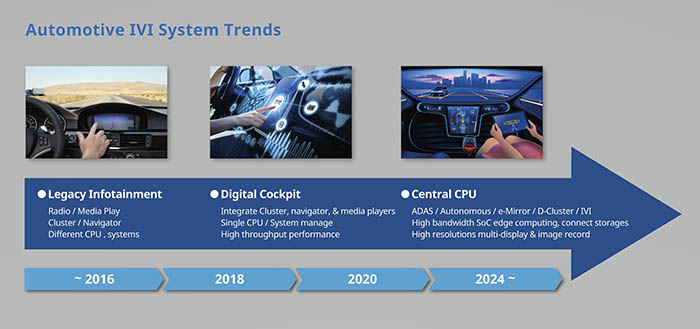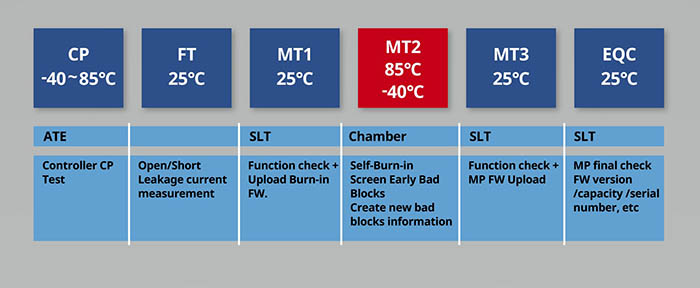New standards for flash-based storage in automotive applications
Silicon Motion explains why Universal Flash Storage (UFS) is a better operational fit for tomorrow’s car designs than eMMC and explains the important performance parameters, product specifications, and supplier considerations to take into account when evaluating embedded UFS storage devices used in automotive applications.
The car is in transition. Once a device primarily for mobility, it is becoming a mobile entertainment and productivity space. Eventually, with the introduction of fully autonomous vehicles, the car will become a type of robot.
These changes will heighten the value that the car buyer attaches to the on-board computing systems for infotainment, safety, system control, the user interface and communications between vehicles and the outside world. Many of these computing systems will depend increasingly on ready access at high speed to vast amounts of data storage capacity.
.jpg)
Above: Figure1. Automotive IVI system trends
The increase in demand for both capacity and speed has driven previous generational shifts in data storage technology in the vehicle, from the old desktop computer-style Hard Disk Drive (HDD) with a PATA or SATA interface solid-state (semiconductor) storage technologies - first SD cards, then eMMC storage. Now the next shift is underway in the automotive sector, from eMMC, now at version 5.1 of the specification, to Universal Flash Storage (UFS), a move which promises to provide automotive OEMs with higher Read/Write speeds – between three and four times faster than eMMC v5.1 – and random IOPS performance (input/output operations per second) as much as two and a half times faster.
This article describes why the UFS interface is a better operational fit for tomorrow’s car designs than eMMC and explains the important performance parameters, product specifications, and supplier considerations to take into account when evaluating embedded UFS storage devices used in automotive applications.
Driving the shift to UFS
The automotive market has been a significant consumer of eMMC storage devices since around 2010. While memory devices based on the eMMC interface were first adopted in the mobile phone in the first decade of the 21st century, automotive manufacturers followed the mobile market’s lead because of the long operating lifetime and higher reliability that eMMC devices offered compared to PATA or SATA hard disk drives, which contain moving mechanical parts that are prone to damage when used in the harsh operating environment of an automobile.
Automotive designers are now reaching the limits of the eMMC interface’s performance - however, they develop new in-vehicle infotainment (IVI) systems capable of supporting more autonomous driving capabilities. These include larger and more sophisticated graphical user interfaces (GUI) and demanding media applications such as high-definition video playback.
To design the next generation of IVI system, automotive designers are rethinking the architecture. In earlier, simpler IVI systems, it was feasible to use a multi-processor architecture in which each element (such as the instrument cluster, the centre information display (CID) and media system, and the navigation system) was controlled by its own, discrete processor chip (see Figure 1). For new car designs, automotive manufacturers are developing the ‘Digital Cockpit’, using a highly integrated architecture. A single, very high-performance processor controls all display functions including the instrument cluster, the media system, navigation and connectivity. In this architecture, data has to flow at a much higher rate into and out of the single processor than in the earlier distributed, multi-processor architecture.

Above: Figure 2. A dual-channel UFS interface offers a dramatic improvement in throughput compared to the legacy eMMC5.x specification. (Image credit: Silicon Motion)
And the performance provided by the eMMC interface is not adequate to the demands that this single-processor architecture imposes on it. Automotive manufacturers are therefore looking beyond eMMC to the next generation of data storage interface. As Figure 2 shows, a standard dual-channel UFS interface offers a far greater maximum throughput than a fifth-generation eMMC.
This theoretical higher data throughput is reflected in the performance attributes of commercially available storage products. A comparison between the performance of Its eMMC-based and UFS storage products is shown in Figure 3.
Now the automotive market can benefit from proven UFS interface technology and abundant supplies of high-performance UFS NAND storage products – although as this paper describes, crucial differences in product attributes and the supply chain distinguish UFS storage products for automotive applications from those in use in consumer devices.
Replacement for eMMC storage devices
The higher data throughput supported by the UFS interface specification compared to eMMC v5.0 or v5.1 provides performance at the product level, which is superior by a factor of more than three, as Figure 2 shows. UFS-based storage supports concurrent Read and Write operations, improving multi-tasking support and providing the end-user with lag-free switching from one application to another. Very high sequential Read speeds offer a smooth, glitch-free experience of high definition video streaming applications. A maximum random IOPS rating of 50,000 means that users enjoy the sensation of instant response from even the most compute intensive applications.
As a result, many automotive manufacturers are now considering the migration of design platforms from eMMC-based storage devices to UFS storage. Automotive users of the Ferri-eMMC series from Silicon Motion, for instance, can migrate to the Ferri-UFS series and benefit from a quick and straightforward design integration process.

Above: Figure 3. the Ferri-UFS products from Silicon Motion offer data throughput rates more than three times faster than its Ferri-eMMC products
The Ferri-UFS product, part number SM671, is a highly integrated solution that combines a feature-rich Flash controller to conform to the latest UFS2.1 specification and standard NAND Flash memory. It supports the UFS v2.1 specification’s advanced features such as HS-Gear3 x 2-lane mode and the command queue function. Also, Ferri-UFS products can be customised via firmware to provide specific features and applications required by the OEM. The SM671, in an 11.5mm x 13mm x 1.2mm 153-ball BGA package, is available with memory capacity options ranging from 16GB up to 256GB.
It is automotive-qualified to AEC-Q100 Grade 3 for operation at up to 85°C (with Grade 2 qualification pending Q2 2019). Its performance is fast - both data transfer rates and initialisation time are more than fast enough for the next generation of automotive IVI designs.
Automotive market considerations
As described previously, UFS storage products such as the Ferri-UFS series provide high memory density at an attractive price thanks to their use of the latest standard 3D TLC NAND Flash. For the automotive market, however, performance and price considerations have to be balanced with the need for ultra-high quality and reliability.
Silicon Motion satisfies this requirement through a combination of:
- The application of stringent quality processes and criteria.
- The implementation of proprietary reliability and data-integrity features.
Strict quality criteria
The quality processes are measured against an overall defect rate for production units shipped to customers, of <10ppm – a defect rate that Silicon Motion has met for every customer, every year, since it began supplying the automotive market in 2014. Strict criteria are also applied to the controller’s specification and NAND dies used in Ferri-UFS products.
The die selection is made only from high-yield wafers drawn from mature (rather than leading-edge) production processes. By this stage, all defects and quality issues have typically been well characterised and can readily be detected. This means that the production process for a Ferri-UFS product starts with known-good dies. Additionally, every part of the Ferri-UFS supply chain, from the foundry that fabricates the controller, to the factory that sorts the wafers, to the test and validation facility, to Silicon Motion itself, is all certified IATF 16949.

Above: Figure 4. Comprehensive high and low temperature test routines are applied to every part shipped to an automotive customer. (image credit: silicon motion)
Automotive traceability requirements are fully supported. The Ferri-UFS device’s controller die includes a unique chip ID stored in one-time programmable memory so that it can be traced back to its original wafer lot and wafer map.
Silicon Motion is committed to automotive quality and this feeds through to final assembly, which takes place on a fully automated line. Test chambers are used to screen every block in every production unit for defects at an operating temperature specified by the customer (see Figure 4). This screening allows Silicon Motion to identify all cells at risk of becoming an early bad block so that the NAND controller can quarantine them before shipment to the customer. All production units are also exposed to extended temperature testing and high/low voltage testing. It is because Silicon
Motion uniformly applies these processes and criteria to all Ferri-UFS products for the automotive customers that production shipments consistently achieve the target.
High data integrity and reliability
In the automotive environment, reliability and a long operating lifespan are core considerations for system designers. For users of UFS storage devices, this calls for a comparative evaluation of two parameters: endurance and data integrity.
This is because of the inherent characteristics of high-density 3D NAND Flash: fabricated in advanced processes with circuit features of 19nm or smaller, the cells in the 3D TLC NAND Flash in Ferri-UFS products are prone to wear with every programme/erase cycle which has the potential to lead to data loss. They are also prone to Read and Write errors unless error correction functions are implemented.
Silicon Motion addresses the issue of endurance by implementing sophisticated global wear levelling technology in its NAND controller.
In addition, it features advanced technology for prolonging data retention, including:
- Static Data Refresh – automatically scans cells at a temperature dependent rate. (data loss accelerates at extreme operating temperatures). This function re-writes data in cells at risk of data loss.
- Early Retirement – automatically analyses blocks and identifies those at high risk of premature data loss and retires them from the memory array.
These and other lifespan operations’ effect is to achieve an endurance rating of 3,000 program/erase cycles, surpassing the benchmark typically set by the automotive industry for IVI storage applications. Data integrity is ensured by applying error correction technology superior to that commonly used in consumer NAND devices. Silicon Motion’s advanced LDPC ECC (Error Correction Code) engine eliminates soft errors in Read and Write operations.
Silicon Motion also implements Enhanced Write Protection which offers permanent, temporary and power-on protection options. Special procedures to protect data in unexpected power loss – a relatively common occurrence in the automotive environment – ensure that data that is being written as power goes down is safely stored before the Ferri-UFS device powers down. These features are backed by 8+1 error detection code applied to the Ferri-UFS SRAM memory.
Finally, the reliability of the total solution provided by Silicon Motion includes its own arrangements for manufacturing and shipping products to meet automotive OEMs’ strict just-in-time requirements. These arrangements include full production redundancy assured by the availability of back-up suppliers for every part of the production process, from the suppliers of NAND Flash and controller wafers to chip assembly operators, screening and module assembly.
Conclusion
Data intensive applications in the car, such as IVI systems, are now undergoing a transition in data storage technology from their current reliance on eMMC-based storage devices to new UFS products using higher density 3D TLC NAND Flash.
Silicon Motion has introduced the Ferri-UFS (SM671) series of products to provide a solution to help meet the highest quality and reliability demands while offering the high performance needed to operate effectively in new single processor architectures deployed in the digital cockpit.
Benefiting additionally from data integrity features such as an LDPC ECC engine and from the NAND Flash know-how of a merchant supplier of SSD/eMMC/UFS controller solutions as well as a robust, redundant supply chain, the Ferri-UFS product line provides a secure way to implement high-performance UFS data storage technology in IVI systems and other compute-intensive applications in the vehicle of tomorrow.







